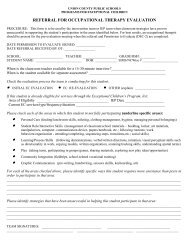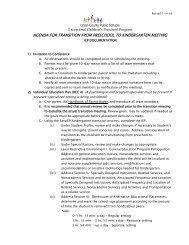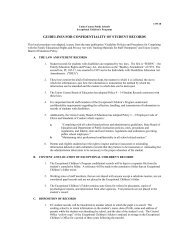FUNCTIONAL VISION SCREENING TEST (Test Instructions Attached)
FUNCTIONAL VISION SCREENING TEST (Test Instructions Attached)
FUNCTIONAL VISION SCREENING TEST (Test Instructions Attached)
You also want an ePaper? Increase the reach of your titles
YUMPU automatically turns print PDFs into web optimized ePapers that Google loves.
<strong>FUNCTIONAL</strong> <strong>VISION</strong> <strong>SCREENING</strong> <strong>TEST</strong><br />
(<strong>Test</strong> <strong>Instructions</strong> <strong>Attached</strong>)<br />
Name_______________________________ Teacher _________________<br />
(Yes) (No)<br />
_____ _____ 1. Pupillary Reaction<br />
_____ _____ 2. Blinks at shadow of hand<br />
_____ _____ 3. Orient peripherally<br />
_____ _____ Right<br />
_____ _____ Left<br />
4. Fixate on 4 inch object<br />
_____ _____ at 12 to 18 inches<br />
_____ _____ at 10 feet<br />
_____ _____ 5. Shifts gaze<br />
_____ _____ 6. Reaches on visual cue<br />
7. Tracks horizontally<br />
_____ _____ Light<br />
_____ _____ Object<br />
8. Tracks vertically<br />
_____ _____ Light<br />
_____ _____ Object<br />
9. Tracks circularly<br />
_____ _____ Light<br />
_____ _____ Object<br />
_____ _____ 10. Converges<br />
_____ _____ 11. Picks up or tracks (3 objects less than 1 inch in size)<br />
_____ _____ a.______________________________<br />
_____ _____ b.______________________________<br />
_____ _____ c.______________________________<br />
_____ _____ 12. No eye preference<br />
If preference circle (right or left)<br />
Action<br />
Taken:__________________________________________________________<br />
Screened By:__________________________<br />
Date:_________________________________<br />
Observations:_____________________________________________________<br />
________________________________________________________________<br />
________________________________________________________________<br />
________________________________________________________________<br />
________________________________________________________________<br />
________________________________________________________________
<strong>FUNCTIONAL</strong> <strong>VISION</strong> <strong>SCREENING</strong> <strong>TEST</strong> INSTRUCTIONS<br />
WHAT: The Functional Vision Screening <strong>Test</strong> is a short form version of the Functional<br />
Vision Screening Inventory.<br />
The items were selected because they proved effective in detecting visual abnormalities.<br />
PURPOSE: The Screening <strong>Test</strong> should be used to discriminate children who exhibit<br />
visual problems so severe that they interfere with the child’s learning processes. This<br />
screening instrument was designed only for the purpose of deciding whether a severe<br />
problem exists.<br />
ADMINISTRATION: The administration procedures for each item are the same as the<br />
procedures outlined in the manual for the Functional Vision Inventory. The only<br />
difference will be in the scoring procedure.<br />
SCORING: Each behavior assessed is scored on either being present or absent. If the<br />
visual behavior being assessed is not within the normal limits, the NO column should be<br />
checked. If no visual problem is suggested, the YES column should be checked.<br />
Four or more checks in the NO column indicate that a visual problem severe enough to<br />
interfere with learning does exist. The child should benefit from educational programs<br />
into which a vision training program has been incorporated.<br />
ADMINISTRATION PROCEDURES<br />
1. PUPILLARY RESPONSE TO LIGHT:<br />
Materials: Penlight<br />
Procedure: Direct the light into the child’s eyes from 12 inches away. Observe whether<br />
the child’s pupils constrict with the introduction of light; then dilate when the light is<br />
removed; and the speed with which they do so; briskly, sluggishly, or no response at all.<br />
Note: Observe the child’s eyes before shining the light; blind children’s pupils may<br />
manifest a continual constricting and dilating process, regardless of the presentation of<br />
light. Observe the pupils as the child moves from one environment to another in which<br />
the room is lighter or darker. Also, observe whether the pupils are equal in size.<br />
SCORE: The child’s pupils should immediately constrict with the presentation of light<br />
and almost as rapidly readjust when the light is removed. If this behavior is observed,<br />
place a check mark in the YES column. If this behavior is not observed, place a check<br />
mark in the NO column.
2. BLINKS AT SHADOW OF HAND:<br />
Materials: None<br />
Procedure: Slowly pass your hand with fingers spread horizontally across the child’s<br />
line of vision. Repeat several times. If the child is nonambulatory, place the child on his<br />
or her back or side and kneel behind the child’s head. Be careful that the child is not<br />
responding to the wind created by your hand, rather than to the oncoming movement of<br />
the hand itself; and that the blinking is in response to the hand, not simply a coincidental<br />
response.<br />
Observe whether the child blinks purposefully as the hand passes over the child’s eyes.<br />
SCORE: The child should blink reflexively to the oncoming hand across his line of<br />
vision. If this behavior is observed, please a check mark in the YES column. If this<br />
behavior is not observed, place a check mark in the NO column.<br />
3. ORIENTS PERIPHERALLY:<br />
Materials: Penlight or small colorful toy<br />
Procedure: Sit behind the child and in front of a mirror, bring the toy or light from<br />
behind the child at eye level. Slowly move it from the periphery and toward the center of<br />
the child’s vision, holding the toy or light approximately 12 to 15 inches away. Move the<br />
toy around the left, as well as the right side, or the child’s head.<br />
Observe the point at which the child turns to look at the toy or light, and any spot<br />
at which the child seems to lose sight of it.<br />
SCORE: The child should turn his or her eyes to each side when the toy or light is at an<br />
angle of 30 inches or more from the midline. If this behavior is observed, place a check<br />
mark in the YES column. If this behavior is not observed, place a check mark in the NO<br />
column.<br />
4. FIXATES ON 4INCH OBJECT:<br />
Materials: Baby Speilzeug, bright orange squeak toy, toy car, yarn ball, nerf ball,<br />
cup, etc., all of which are approximately 4 inches in size.<br />
Procedure: Attract the child’s attention to the object at 12 to 18 inches by wiggling the<br />
toy or activating a sound component if possible. Position the object at various places<br />
within a 180 degree radius around the child, then move back five feet, wiggle or activate<br />
the object. Again, position the toy at various places within a 3foot radius of the child.<br />
Move back to 10 feet, then repeat.<br />
Observe whether the child fixates (looks at) his or her gaze for 3 seconds on the object<br />
in any position within 12 to 18 inches of the child. At 510 feet, observe whether the<br />
child turns his or her head, or eyes, to fixate or look at the object for 3 seconds or more<br />
in any position. If the child can sign or is verbal, teach the sign or label for the toys and<br />
ask the child to name them at 10 feet away.<br />
SCORE: The child should look at the object for 3 seconds at 12 to 18 inches and at 10<br />
feet. If this behavior is not observed, a check mark should be placed in the NO column.
5. SHIFTS GAZE:<br />
Materials: Two toys from 24 inches in size identical in interest appeal Weebles,<br />
puppets, spinner toys, plastic animals, etc.<br />
Procedure: Hold the two objects before the child 10 inches from his or her eyes with<br />
approximately 6 inches between the objects. Attract the child’s interest to one object<br />
and allow the child to attend several seconds before attracting his or her attention to the<br />
other. Repeat several times. If the toys differ, alternate the position of the toys several<br />
times.<br />
Observe the shift of gaze from one toy to the other attending to only one side, or for<br />
difficulty in shifting to or locating the other toy.<br />
SCORE: The child should be able to shift his gaze easily and quickly from one toy to the<br />
other, 4 or 5 times in 5 seconds. If this behavior is observed, place a check mark in the<br />
YES column. If this behavior is not observed, place a check mark in the NO column.<br />
6. REACHES ON VISUAL CUE:<br />
Reaches for Stationary Toy:<br />
Materials: Any bright object, toy, or cup filled with juice.<br />
Procedure: Throughout the assessment, leave different size objects in various areas in<br />
a circumference around the child. Be alert to any attempt during the observation of the<br />
child, to reach for, or follow, or gaze at different types of objects. Be sure to record<br />
these observations, even if they are made while returning the child to the classroom.<br />
Observe whether the child reaches for objects on only one side. Switch the positions of<br />
the objects that the child does reach for to see whether the child prefers that object or<br />
whether the child does not see in that field.<br />
SCORE: A child of 5 months (chronologically or older) should reach for objects within<br />
his or her visual field. When propped upright or sitting on the floor, the child of 10<br />
months or older should pick up small objects within 18 inches. If this behavior is<br />
observed, place a check mark in the YES column. If this behavior is not observed, place<br />
a check mark in the NO column.<br />
79. TRACKS HORIZONTALLY, VERTICALLY, AND CIRCULARLY:<br />
Materials: Penlight or a light covered with plastic figures that allow light to shine<br />
through. Big Bird puppet, Baby Spielzeug, slinky, Redheaded Rattle, a cup, spoon,<br />
bottle, patterned box, or face.<br />
Procedure: Hold the light source 12 inches from the child’s eyes and blink it several<br />
times to attract the child’s attention. Slowly move the blinking light in an arc to the far<br />
left, then to the far right (horizontally). From the center point (directly before the nose)<br />
move the light in an arc to several inches above the child’s chin (vertically). Next, move<br />
the light in a circular pattern (circumference should be no larger than 12 inches). The<br />
circular motion should be conducted vertically around the child’s face, pause, then<br />
repeat. Follow the same sequence with a toy or object. If the child does not attend to a<br />
stationary toy, wiggle it to create another form or motion as it is being moved across the<br />
child’s visual field.
Observe whether the child follows the light or the object, the direction in which the child<br />
follows, and how the child follows. Does the child follow with both eyes together, or with<br />
only one eye, which? Does the child’s eyes follow smoothly or jerkily? Does the child<br />
cross his midline or look only from the midpoint to one direction? Can the child follow<br />
with only his or her eyes or does the child also move his or her head?<br />
SCORE: The child should be able to follow both light and object smoothly in all<br />
directions. If this behavior is observed, place a check mark in the YES column. If this<br />
behavior is not observed, place a check mark in the NO column.<br />
10. CONVERGENCE:<br />
Materials: Penlight, small puppet, flint sparkler, slinky, or Weeble.<br />
Procedure: Sit before the child with the toy or light and attract the child’s attention to it.<br />
When the child attends, move the toy or light slowly in toward the bridge of the child’s<br />
nose from about 12 to 16 inches away.<br />
Observe the child’s eyes as the toy or light moves toward the child, paying particular<br />
attention to the distance at which the eyes turn in or out, or if the child looks away, turns<br />
his or her head, or closes his or her eyes. The eyes should continue to converge on the<br />
toy or light until it is 4 inches from the child’s nose. Note also, whether both eyes turn in<br />
simultaneously or whether one eye turns in or out.<br />
SCORE: The child should follow the light or object with both eyes until the stimulus is<br />
approximately 4 inches from the child’s eyes. If this behavior is observed, place a check<br />
mark in the YES column. If this behavior is not observed, place a check mark in the NO<br />
column.<br />
11. PICKS UP OR TRACKS 3 OBJECTS LESS THAN 1 INCH IN SIZE:<br />
Bead/Thread <strong>Test</strong>:<br />
Materials: Cake decorations (1) silver beads 3 mm in size, and (2) colored beads 1<br />
mm in size, and 2inch lengths of red sewing thread.<br />
Procedure: Position the child over a bolster or wedge, on the floor, or at a table. Be<br />
sure that there is a high contrast between the materials and the table or surface on<br />
which they rest. Scatter the large beads first, the smaller ones next, and the threads<br />
last. The child should be exposed to only one set of items at a time.<br />
Observe the child for any focusing or attempts to pick up the objects. If this behavior is<br />
observed, place a check mark in the YES column. If this behavior is not observed, place<br />
a check mark in the NO column.<br />
12. NO EYE PREFERENCE<br />
Materials: Objects administered during the assessment.<br />
Procedure: Observe during the administration of items whether the child closed either<br />
eye to look from only one. Does the child track with only one eye? When either eye is<br />
covered, does the child resist? When objects are brought into the left and then to the
ight visual fields (from behind the child’s head), does the child turn to one side and then<br />
to the other?<br />
Holt and Reynell (1967, p. 27) discussed the relationship between head posture and<br />
muscle imbalance. Two of the most common defects associated with muscle imbalance<br />
are described below:<br />
OCULAR POSTURE – Eye turned in.<br />
USUAL COMPENSATORY HEAD POSTURE – Face turned towards affected side, chin<br />
lowered.<br />
OCULAR POSTURE – Eye turned out.<br />
USUAL COMPENSATORY HEAD POSTURE – Face turned towards normal side, chin<br />
may be raised.<br />
SCORE: The child should maintain his or her head in midline when focusing on objects.<br />
No preference for one eye should be noted either during occlusion through head<br />
posture, or when gathering acuity data. If this behavior is observed, place a check mark<br />
in the YES column. If this behavior is not observed, place a check mark in the NO<br />
column.<br />
<strong>FUNCTIONAL</strong> <strong>VISION</strong> ASSESSMENT<br />
QUESTIONS TO ASK PARENTS<br />
1. Is your child taking any medications? Are there any medical issues we should be<br />
aware of?<br />
2. What kinds of things do you think your child sees?<br />
3. Does your child recognize people when they enter the room (without an auditory<br />
cue).<br />
Will the child raise his or her arms to be picked up?<br />
4. How far away does the person have to be before the child recognizes the person?<br />
5. Have you noticed your child squinting when in bright sunlight or when near bright<br />
lights?<br />
6. Does your child appear to tilt his or her head in an unusual way to look at things?<br />
7. Does your child hold his or her hand or objects near his or her eyes in an unusual<br />
manner?<br />
8. Does your child locate things he or she drops on the floor? Does the child use vision
to locate lost objects? How?<br />
9. Does your child appear to notice if the room lights are on or off?<br />
10. Is your child interested in watching television?<br />
11. What pictures capture your child’s attention?<br />
12. What are your child’s favorite toys and color preference? Candy is a useful tool for<br />
color testing, determining size of object seen, and eye/hand coordination.
















